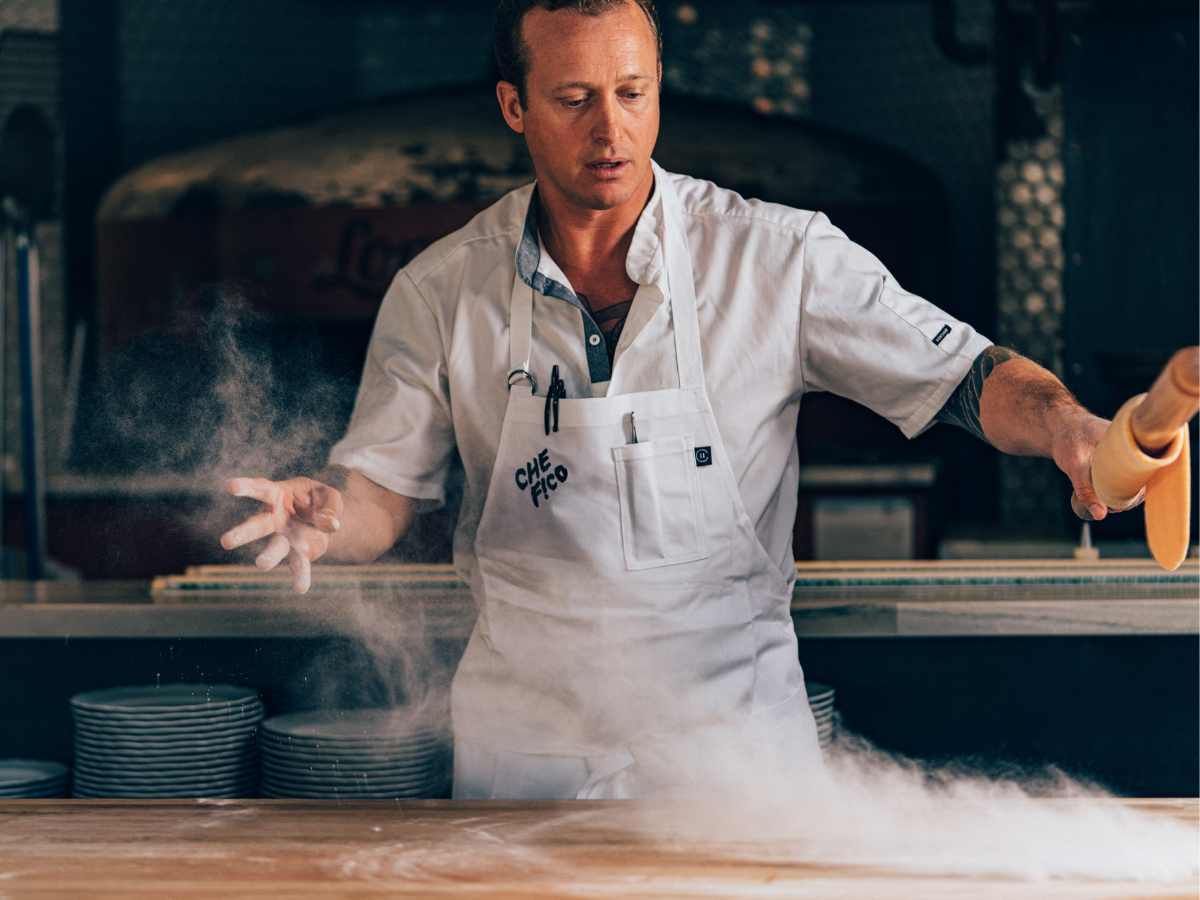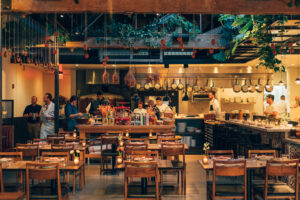

Chef David Nayfeld grew up in Alameda and attended the prestigious Culinary Institute of America before working for distinguished chefs in the United States and Europe. He benefited from formative stints at prestigious restaurants like Tickets and 41 Degrees in Barcelona (with Albert & Ferran Adria), Philippe Rochat in Switzerland, Jacques Genin in Paris, Mauro Colagrecco at Mirazur and Clare Smyth from Gordon Ramsay in London. After Nayfeld returned to the States, he was the first chef to steer Fifty-Seven, a seasonal pop-up with rotating chefs in L.A.’s Downtown Arts District.

Picture by Eric Wolfinger
In 2018, he moved back home to the Bay Area and partnered with Matt Brewer to debut Che Fico, an “Italian taverna” in San Francisco’s NoPa neighborhood that required major renovations. “Most people would really be turned off and sent away by the idea of how big a challenge and how unrealistic it would be to convert an old auto body shop into a restaurant,” Nayfeld says. “That challenge seemed like exactly the type of complexity I needed to give me an edge.” Che Fico required some heavy lifting to open, but the effort paid dividends. They earned early support from diners and national publications, including the #7 slot on Bon Appetit’s “America’s Best New Restaurants 2018” list.
Buoyed by early success, the duo debuted Che Fico Alimentari downstairs in 2019. Recently, Nayfeld and Brewer re-opened Che Fico Pizzeria at San Francisco’s Thrive City and expanded Che Fico to Menlo Park’s Springline development. As he says, “When it rains, it pours.” In a rare spare moment, Nayfeld took time to discuss Flannery Beef and cooking great steaks.
How did you discover Flannery Beef?
Flannery Beef has been around for a long time, and I’ve been familiar with them for a long time growing up in the Bay Area and cooking.
What makes Flannery Beef such a good fit for what you’re doing at Che Fico?
We’ve grown to appreciate the consistency that they have. There are a lot of companies out there that you can get really amazing stuff from, especially here in the Bay Area, but restaurants like ours, that are as busy as we are, and as popular as we are, we thrive on consistency. Our cuisine is fairly simple. We don’t have pageantry or a million gadgets and garnishes. We do simple food. That’s something that I pride myself on. We’re ingredient forward. And if we have a partner who’s a purveyor or provider, we have to count on their products being not just excellent, but consistently excellent. And I feel like Flannery does a great job at that.
What are your current Flannery Beef menu offerings?
We were making bistecca ribeye from them [recently served with maitake mushroom, hazelnut and pickled green garlic]. We’re doing a bavette cut for our carne cruda. We also work with some local purveyors and local ranchers. Flannery comes in and out of that mix.
What’s the first word that comes to mind when you think of Flannery Beef?
Consistency.
What is your favorite steak to eat and why?
I fluctuate between a ribeye and a bavette. The ribeye, I love. To me, it’s the most flavorful of all the steaks. It’s fatty, and delicious, and I love the texture. And I love the versatility between doing a big Prime rib, tomahawk, or steaks, and the different sizing. Bone on, bone off.
The bavette, I really love. To me, it’s got a really rich, beefy flavor, but doesn’t have the same amount of fat on it. And it’s really easy and quick to cook, which I love for convenience purposes, and less expensive. So you get a really great bang for your buck with the bavette.
What are your preferred methods for cooking the ribeye and bavette?
I like to marinate the bavette either with garlic, olive oil, herbs and spices or something more exotic like ginger, soy, and garlic. I like to marinate it and then grill it. It does really, really well.
The ribeye, depending on whether it’s a steak, I prefer to sear it in a pan and then butter baste it with herbs, and depending on how thick it is, potentially finish it in the oven or not. Obviously a rib roast is different. I really like smoking a whole rib roast. I think that’s one of the most underappreciated ways of doing a Prime rib.
Which drink are you pairing with your ribeye and bavette?
Over the past few years, I have started drinking way less. I just really toned that down. So my answer is gonna be boring: water or sparkling water. But when I am in a place where I want to enjoy that, I really like a cold Negra Modelo when I’m grilling steak. I think that’s delicious. Or when I’m having roasted ribeye, I really like a nice Sangiovese, like super Tuscan wine. I think there’s not really a whole lot better you can do than that.
What are some quick tips for nailing a perfect steak at home?
Don’t cook cold steak. That’s the biggest thing. Pull the steaks out of your refrigerator and let them sit for anywhere from an hour to even more. If you’re marinating, you can marinate on a countertop and let it stay at room temp for a long time. That way, you’re gonna cook the steak, and it’s gonna get to an internal temperature faster without creating a gray ring around the outside. Then, obviously, the one that everyone knows is making sure that you rest your steak adequately before you slice it.
